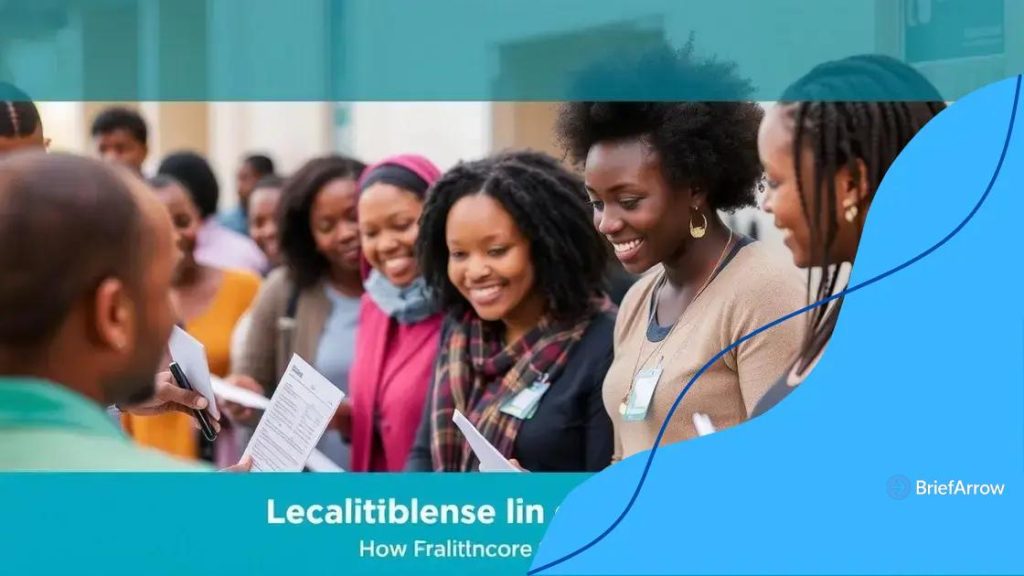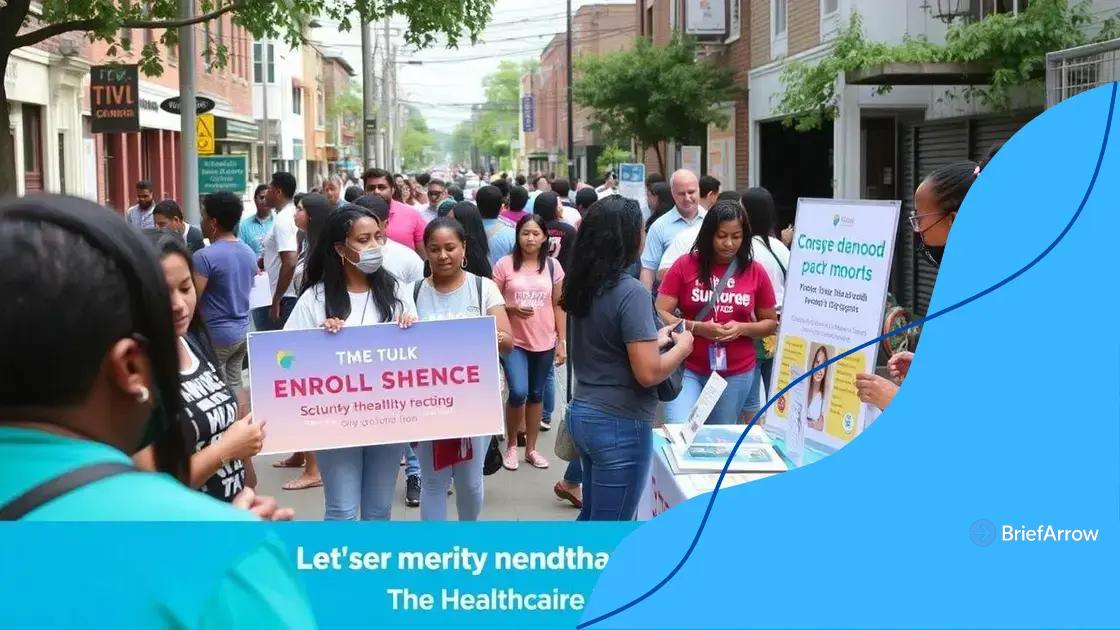Public awareness campaigns for healthcare enrollment strategies

Anúncios
Public awareness campaigns for healthcare enrollment are crucial for informing communities about their options, engaging them effectively, and ultimately increasing participation in health insurance programs.
Public awareness campaigns for healthcare enrollment play a crucial role in ensuring communities understand their options. Have you ever wondered how these initiatives can actually boost participation? Let’s dive into the effective strategies that make a difference.
Anúncios
Understanding healthcare enrollment
Understanding healthcare enrollment is essential for accessing medical services. When individuals know their options, they can make informed decisions.
Healthcare enrollment involves selecting a plan that fits your needs. It’s a process that can seem overwhelming, but breaking it down makes it easier to grasp.
What is healthcare enrollment?
Healthcare enrollment is the period when individuals can sign up for health insurance. This usually happens once a year, but some special circumstances allow for enrollment outside this window.
Anúncios
Why is understanding important?
When people understand the enrollment process, they are more likely to participate. This leads to better coverage for families and communities. Here are some points that illustrate this:
- Better Coverage: Individuals can choose plans that suit their healthcare needs.
- Cost Savings: Selecting the right plan can reduce out-of-pocket expenses significantly.
- Access to Care: Enrollment ensures access to necessary medical services.
Many may not realize that the enrollment period is limited. It is crucial for individuals to mark their calendars and prepare ahead of time. Investigating different plans allows time to compare benefits and costs.
Furthermore, understanding the terminology used in healthcare can also help in making the right decision. Terms like ‘premium,’ ‘deductible,’ and ‘co-pay’ play a significant role in how costs are calculated. By clarifying these terms, individuals can better navigate their choices.
As enrollment approaches, consider reaching out for assistance. Local resources or community health organizations often provide help to those unsure about the enrollment process.
The role of public awareness campaigns
The role of public awareness campaigns in healthcare enrollment is crucial. They help inform communities about the options available to them.
These campaigns aim to educate individuals on how to navigate the enrollment process and encourage them to participate. By using clear messaging, public awareness campaigns make important information accessible.
How do public awareness campaigns work?
Public awareness campaigns utilize various channels to share important information. They often include:
- Social Media: Leveraging platforms like Facebook and Twitter to reach a wider audience.
- Community Events: Hosting events where people can ask questions and get help.
- Informational Materials: Distributing brochures and flyers in public spaces.
These methods help to increase visibility and encourage participation. Through engaging content, campaigns can grab the attention of individuals who might not actively seek out information. They provide vital resources to help families make informed choices about their healthcare.
Additionally, these campaigns often focus on overcoming barriers to enrollment. Many individuals may feel confused or intimidated by the process. Campaigns strive to simplify information, making it easier for people to understand.
Using relatable stories and testimonials also plays a key role in these campaigns. Hearing from real people about their enrollment experiences can inspire others to take action. By showcasing positive outcomes, campaigns can motivate individuals to participate in the healthcare system.
Effective strategies for outreach

Effective strategies for outreach in public awareness campaigns are vital for engaging communities. By using the right techniques, organizations can connect more effectively with people.
One of the most impactful methods is utilizing social media platforms. Social media allows campaigns to reach a large audience quickly. Engaging content like videos and infographics can capture attention and spread awareness.
Key outreach strategies
There are several important strategies that can enhance outreach efforts:
- Community Partnerships: Collaborating with local organizations helps build credibility and expand reach.
- Targeted Messaging: Tailoring messages to specific demographics ensures relevance and engagement.
- Visual Storytelling: Using compelling visuals to share stories can make the message resonate more.
In addition to these strategies, hosting community events plays a significant role in outreach. These events allow for direct interaction, providing valuable opportunities for education and support. People feel more connected when they can ask questions and engage face-to-face.
It’s also crucial to provide clear and accessible information. Many individuals might feel overwhelmed by technical jargon. Simplifying terms and using straightforward language can help them understand their options better.
Using feedback from the community enhances the effectiveness of future campaigns. Listening to concerns and suggestions can adapt the approach and address specific needs. This interaction fosters trust and loyalty among community members.
Engaging the community in healthcare
Engaging the community in healthcare enrollment is essential for increasing participation rates. When people feel involved, they are more likely to take action regarding their health.
One effective way to engage communities is by fostering trust through transparency. When information is shared openly, people are more willing to participate. This builds a strong foundation for collaboration between health agencies and community members.
Building Connections
Creating strong connections with community leaders can enhance engagement. Leaders often serve as trusted voices, and their endorsement can significantly influence public perceptions.
- Workshops and Seminars: Hosting educational sessions to explain healthcare options and address questions.
- Feedback Mechanisms: Implementing ways for community members to share their thoughts and experiences.
- Local Partnerships: Collaborating with local businesses and organizations to spread the message more effectively.
Regular communication is also key to keeping the community engaged. Emails, newsletters, and social media updates can keep individuals informed about upcoming enrollment periods and available resources. Using stories from community members who have successfully enrolled encourages others to consider their options.
Additionally, providing incentives for participation can be a motivator. Offering discounts or small rewards for attending informational sessions can boost involvement. Gamification techniques, like contests, can also make the process more interactive and fun.
Lastly, remember that engagement is not a one-time effort. Ongoing support is needed to maintain relationships with the community. Regular follow-ups and check-ins can reinforce the importance of healthcare enrollment, showing that it is not just a seasonal task but a continuous journey.
Measuring the success of campaigns
Measuring the success of public awareness campaigns for healthcare enrollment is crucial. It helps organizations understand what works and what needs improvement.
To effectively gauge success, tracking specific metrics is essential. These metrics can provide valuable insights into the campaign’s impact on the community.
Key Metrics to Consider
There are several important metrics that can help measure the success of awareness campaigns:
- Enrollment Rates: Tracking how many people enroll during and after the campaign.
- Engagement Levels: Measuring likes, shares, and comments on social media posts.
- Event Attendance: Counting how many people attend informational events or workshops.
- Feedback Surveys: Collecting opinions from participants about the campaign’s effectiveness.
These metrics can indicate which strategies were the most effective. For instance, if social media posts resulted in more engagement than flyers, organizations can focus on online strategies in the future.
Additionally, ongoing evaluation is necessary. After a campaign concludes, conducting follow-up surveys allows organizations to gain insight into long-term effects. This helps in understanding how well the community retained the information.
Using data visualization tools can also enhance understanding. Creating graphs and charts to depict enrollment trends can make the information clearer and more accessible. Furthermore, sharing these results with the community can promote transparency and encourage ongoing engagement in future campaigns.
In conclusion, effective public awareness campaigns for healthcare enrollment play a vital role in ensuring that communities have access to the information they need. By utilizing outreach strategies like social media and community events, organizations can engage individuals and encourage participation. Measuring the success of these campaigns through key metrics allows for continuous improvement and adaptation. Together, these efforts contribute to healthier communities and improved access to healthcare options.
FAQ – Frequently Asked Questions about Public Awareness Campaigns for Healthcare Enrollment
What is the main goal of public awareness campaigns?
The main goal is to inform communities about healthcare enrollment options and encourage participation.
How can social media be used in these campaigns?
Social media can reach a large audience quickly through engaging content like videos and infographics.
What metrics should be tracked to measure campaign success?
Important metrics include enrollment rates, engagement levels, event attendance, and feedback from participants.
How does community engagement help in healthcare enrollment?
Engaging the community fosters trust and encourages individuals to participate in their healthcare options.